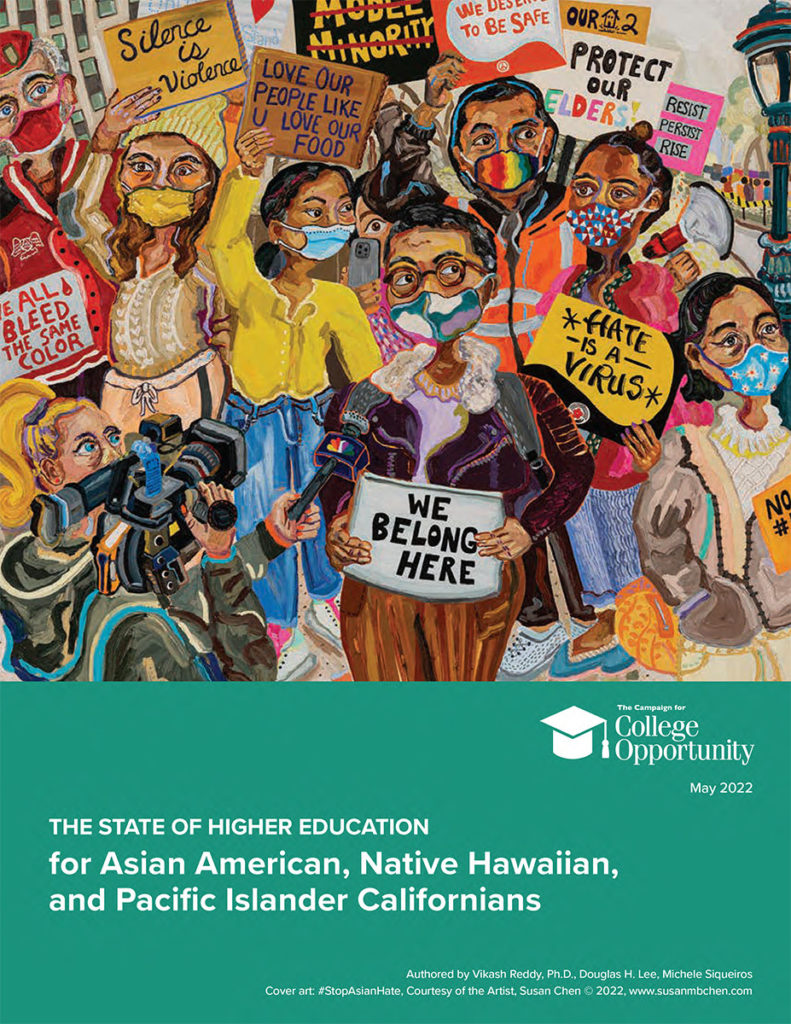A new report delves into the college trends of Asian subgroups in California, aiming to debunk misperceptions that all Asian Americans do well in college and don’t face the same challenges as students from other races and ethnicities.
The Campaign for College Opportunity notes that too often the needs of various Asian ethnic groups — including Native Hawaiians and Pacific islanders — are not recognized because data about Asian students are typically clumped together, with information on high-achieving students skewing the averages. In its annual report released this week, the Campaign disaggregates federal and state data on Asian students to get a more accurate picture of subgroups, including the colleges they attend, transfer and graduation rates, developmental education, employment, poverty and more.
“By masking the distinctions in both access to higher education and success after college enrollment, college leaders and policymakers do not have a clear picture from which to make informed decisions,” the Campaign said, noting that AANHPI Californians are the fast-growing and second-largest ethnic group in the state, next to Latinx.
First-time freshmen and overall enrollments
The report examines promising trends and trouble spots in each of the state’s three public higher education systems. For example, in 2019-20, 59% of AANHPI undergraduates in California attend community college, compared to 15% of Asian American undergrads enrolling in the Univerisity of California (UC) system and 16% in the California State University (CSU) system. Only 4% of California NHPI undergrads attended UC and 10% enrolled at CSU.
However, as with all other ethnic groups, the Covid pandemic has had a huge impact on AANHPI students — their enrollments at the state’s community colleges plummeted 20% during the pandemic.
The report shows that 41% of Asian Americans in California begin their higher education path at a community college, more than any other system, the report says. Though Latinx Californians attending college for the first time are the most likely to enroll in a community college, the share of NHPI first-time students enrolled in a California community college has grown to 59%, nearly equal to the share of Latinx students, it adds.
In fall 2020, more than 20,000 Asian Americans and 1,107 NHPI first-time freshmen in California attend a community college. Filipino students (23%) represent the largest share of AANHPI first-time freshmen enrollment, followed by Chinese (22%), Vietnamese (14%) and Indian (13%) students, the report says.
“Of the three systems, CCC (California Community Colleges) representation matches the closest with California demographic representations,” it says.
Success and transfer rates
The College Campaign also examined AANHPI students’ success in college, including community college, over a two-, four- and six-year period. Only about 7% of Asian Americans and 5% of NHPI students who enrolled in 2013-14 earned an associate degree or certificate within two years, the report says. The rate increased over a six-year time frame, with 15% of Asian Americans earning a credential.
However, diving deeper into the data shows a range of success rates in the subgroups. For instance, a community college credentials earned over six years was 20% for Vietnamese students, 16% for both Filipinos and Cambodians, 14% for Chinese, 14% for Indians, 12% for Koreans and 9% for Native Hawaiians.
The report also breaks down transfer rates over a six-year period among the different groups. It notes that 38% of Asian Americans and 22% of NHPI students enrolling in 2013-14 transferred to a four-year institution within six years. Rates for Chinese and Indian students were 42% each, while only 20% of Native Hawaiians and 19% of Samoan students did so.
Other areas
California’s efforts to reform developmental education at community colleges appear to have a positive effect on AANHPI students. The percentage of students enrolling in pre-transfer coursework has dropped for all Asian American students, from 18% to 13%, and from 25% to 17% for NHPI students, the report says. The gains in access were seen by students in every subgroup with the AANHPI populations, it notes.
The Campaign also examined undocumented AAHPI students. Though much of the discussion around undocumented individuals focuses on the Latinx population, the report observes that Asians are the fastest-growing undocumented racial group in the U.S. and California. The nearly 447,300 undocumented Asian immigrants in the state — comprising almost one-fifth of California’s undocumented population — come from many different countries, but more than half (52%) come from India and China (26% each). Four of the top 24 countries of origin for DACA recipients are in Asia (South Korea, the Phillipines, India and Pakistan), and Asians represent almost 10% of the population potentially eligible for DACA, the report says.
The Campaign highlighted the work of Asian American and Native American Pacific Islander-serving institutions (AANAPISI). More than half (52%) of all AANHPI community college students enrolled in an AANAPISI in 2018, compared to 43% in 2013. Thirty-five of the state’s 68 colleges and universities that meet the criteria for AANAPISI designation are community colleges. Another 11 are potentially eligible.
The report notes the work of colleges that received AANAPISI grants in 2020 and 2021. For example, Cosumnes River College is using its grant funds to focus on coaching, support services in math and science, and a summer bridge program for AAPI and low-income students. The college is one of six regional community colleges and Sacramento State University that are sharing a $2 million federal AANAPISI grant received last fall.


